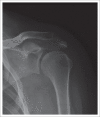The use of clickers to evaluate radiographer's knowledge of shoulder images
- PMID: 31934404
- PMCID: PMC6917440
- DOI: 10.4102/hsag.v24i0.1053
The use of clickers to evaluate radiographer's knowledge of shoulder images
Abstract
Background: Conducting research can be daunting, although applicable methods can facilitate the process. A study was performed at an imaging department pertaining to the routine shoulder projections, namely the anteroposterior (AP) external rotation and lateral-Y (LAT-Y) projections.
Aim: The aim of the study was to determine if radiographers (qualified, supplementary, community service) and student radiographers (second-year diploma, third-year diploma, second-year bachelor) use the radiographic evaluation criteria to evaluate the routine shoulder projections.
Setting: The study was conducted at an imaging department in the Free State province, South Africa.
Methods: Participants had to complete a survey by means of a questionnaire that was compiled in Microsoft Excel and converted to an audience response system known as clickers. The questions addressed aspects of shoulder imaging with regard to positioning, exposure factors and the evaluation of routine shoulder projections. The data were analysed separately using statistics software SAS Version 9.2. Fisher's exact test was used to determine statistically significant differences between students and radiographers.
Results: More than 80% of students selected the AP (external rotation) X-ray image demonstrating optimal milliamperage per second whereas 43% of radiographers selected the correct image. More than 50% of radiographers and students indicated that a breathing technique and a short exposure time reduce motion during shoulder imaging.
Conclusion: Using clickers eased the process of testing the participants' knowledge, and the results were available immediately after completion of the test. Clickers can contribute to and expedite the process of data analysis.
Keywords: clickers; criteria; knowledge; radiography; shoulder imaging.
© 2019. The Authors.
Conflict of interest statement
The author declares that she has no financial or personal relationships that may have inappropriately influenced her in writing this article.
Figures







References
-
- Blasco-Arcas L., Buil I., Hernández-Ortega B. & Sese F.J, 2013, ‘Using clickers in class. The role of interactivity, active collaborative learning and engagement in learning performance’, Computers and Education 62, 102–110. 10.1016/j.compedu.2012.10.019 - DOI
-
- Brink H., Van Der Walt C. & Van Rensburg G, 2012, Fundamentals of research methodology for healthcare professionals, 3rd edn., Juta, Cape Town.
-
- Delport C.S.L. & Roestenburg W.J.H, 2011, ‘Quantitative data-collection methods: Questionnaire, checklists, structured observation and structured interview schedules’, in De Vos A.S., Strydom H., Fouché C.B. & Delport C.S.L. (eds.), Research at grass roots. For the social sciences and human service professions, 4th edn., pp. 171–205, Van Schaik Publishers, Pretoria.
-
- Duncan D, 2005, Clickers in the classroom. How to enhance science teaching using classroom response systems, Pearson Addison Wesley, San Francisco, CA.
-
- Goddard W. & Melville S, 2001, Research methodology. An introduction, 2nd edn., Juta, Lansdowne.
LinkOut - more resources
Full Text Sources
Research Materials
